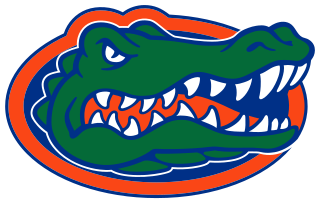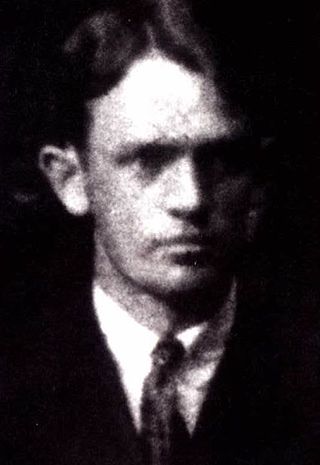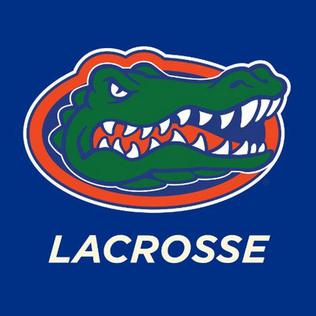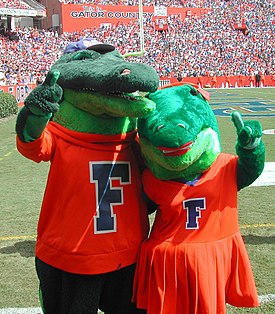
The University of Florida is a public land-grant research university in Gainesville, Florida, United States. It is a senior member of the State University System of Florida. The university traces its origins to 1853 and has operated continuously on its Gainesville campus since September 1906.

The Florida Gators are the intercollegiate athletic teams that represent the University of Florida, located in Gainesville. The University of Florida, its athletic program, its alumni and its sports fans are often collectively referred to as the "Gator Nation." The Gators compete in the National Collegiate Athletic Association (NCAA) and the Southeastern Conference (SEC) and are consistently ranked among the top college sports programs in the United States. The University of Florida currently fields teams in nine men's sports and twelve women's sports.

Ben Hill Griffin Stadium, popularly known as "The Swamp", is a football stadium in Gainesville, Florida, United States. It is located on the campus of the University of Florida and is the home field of the Florida Gators football team. It was originally known as Florida Field when it opened as a 22,000-seat facility in 1930, and it has been expanded and renovated many times over the ensuing decades. Most of the university's athletic administrative offices, along with most football-related offices and training areas, have been located in the stadium since the 1960s. Most of the football program's facilities are slated to move to a nearby $60 million building that began construction in 2020.

The Independent Florida Alligator is the student newspaper of the University of Florida. The Alligator is one of the largest student-run newspapers in the United States, with a circulation of 14,000 and readership of more than 21,000. It is an affiliate of UWIRE, which distributes and promotes its content to their network.

The Florida–Miami football rivalry is an American college football rivalry between the Florida Gators football team of the University of Florida and Miami Hurricanes football team of the University of Miami. The game was played annually from 1944 until 1987, and is now played intermittently. The winning team was formerly awarded the Seminole War Canoe Trophy. Today, the round robin winner of the three schools in the state of Florida receives the Florida Cup for beating the other two schools in the same season. The two teams will next play in the 2024 and 2025 seasons. Miami leads the series 30–27.

The Florida Gators football program represents the University of Florida (UF) in American college football. Florida competes in the Football Bowl Subdivision (FBS) of the National Collegiate Athletic Association (NCAA) and the Southeastern Conference (SEC) They play their home games on Steve Spurrier-Florida Field at Ben Hill Griffin Stadium on the university's Gainesville campus.

Gator Growl, produced by Florida Blue Key with artists funded by Student Government Productions, is a student-run pep rally at the University of Florida that was founded in 1924. It marks the culmination of Homecoming Week at the university.

The Florida Gymnasium is a historic building located on the campus of the University of Florida (UF) in Gainesville. It opened in 1949 as a 7,000-seat multi-purpose arena and served as the home court of the Florida Gators men's basketball team and other UF indoor sports programs for over thirty years, acquiring the nickname of "Alligator Alley" during that time.

The University of Florida Fightin' Gator Marching Band, also known as The Pride of the Sunshine, is the official marching band for the University of Florida. The current era of the band is also referred to as The Sound of the Gator Nation. They perform at every Florida Gators home football game at Ben Hill Griffin Stadium and also at various other events such as pep rallies, parades, and the annual Orange and Blue spring scrimmage game. A full band usually travels to two away games a year while at other games a small/medium-sized pep band will attend. Members of the Gator Band, as well as other University of Florida students, are encouraged to join other ensembles such as concert band, jazz band, basketball band, and volleyball band. The twirlers for the Gator Band are referred to as the Gatorettes and the color guard is called the Florida Visual Ensemble.

The Mark Bostick Golf Course at the University of Florida, located in, is the home course of the Florida Gators men's golf and Florida Gators women's golf teams. The course is owned by the university and operated by the University Athletic Association (UAA).

"The Orange and Blue" is the traditional fight song of the Florida Gators intercollegiate sports teams of the University of Florida in Gainesville, Florida.

George E. Edmondson Jr. was an insurance salesman from Tampa, Florida who was known to the University of Florida community as "Mr. Two Bits". Edmondson was a fan of the Florida Gators football team, for which he led a traditional "Two Bits' cheer" at football games beginning in 1949. Though he began the practice in an unofficial capacity, it eventually became so popular among fans at Florida Field that he was invited to lead the cheer from midfield before games, which he did from the mid-1970s until 2008. Citing health concerns, he retired from the role after the 2008 season and died in 2019.

James Adger "Jack" Forsythe Jr., nicknamed "Pee Wee" Forsythe, was an American college football player and coach. Forsythe has an important place in the history of college athletics in the U.S. state of Florida as the first head coach of the team now known as the University of Florida Gators. He had previously been the last football coach at Florida State College, now Florida State University, before it was reorganized as a school for women.

The Florida Gators women's lacrosse team represents the University of Florida in the sport of college lacrosse. The Gators compete in Division I of the National Collegiate Athletics Association (NCAA) and are single-sport members of the Big 12 Conference, which they joined after the 2024 season. Previously, the team had competed in the American Athletic Conference, and before that the Big East Conference. Before joining Big East women's lacrosse, the Gators were members of the American Lacrosse Conference (ALC), which folded after the 2014 season due to aftereffects of conference realignment. They play their home games in Donald R. Dizney Stadium on the university's Gainesville, Florida campus, and are currently led by head coach Amanda O'Leary. The Gators have won regular-season conference titles in 11 of the 13 completed seasons of the women's lacrosse program's existence, with four each in the ALC and Big East plus three in The American. Additionally, they have won 10 conference tournament titles and advanced to the quarterfinals of the NCAA tournament six times, with their best NCAA finish being a semifinal berth in 2012.

The history of the University of Florida is firmly tied to the history of public education in the state of Florida. The University of Florida originated as several distinct institutions that were consolidated to create a single state-supported university by the Buckman Act of 1905. The oldest of these was the East Florida Seminary, one of two seminaries of higher learning established by the Florida Legislature. The East Florida Seminary opened in Ocala 1853, becoming the first state-supported institution of higher learning in the state of Florida. As it is the oldest of the modern University of Florida's predecessor institutions, the school traces its founding date to that year. The East Florida Seminary closed its Ocala campus at the outbreak of the American Civil War and reopened in Gainesville in 1866.

The University of Florida Athletic Hall of Fame includes over 300 former Florida Gators athletes who represented the University of Florida in one or more intercollegiate sports and were recognized as "Gator Greats" for their athletic excellence during their college sports careers. The University of Florida, located in Gainesville, Florida, is a member of the Southeastern Conference (SEC), and fields twenty-one intercollegiate sports teams, all of which compete in Division I of the National Collegiate Athletic Association (NCAA).
The 1906 Florida football team was the first intercollegeate football squad fielded by the University of Florida, which was established in 1905 and opened its new Gainesville campus for the 1906–1907 academic year. Florida was a member of the Intercollegiate Athletic Association of the United States (IAAUS) but was not yet affiliated with an athletic conference. The university had not yet constructed on-campus sports facilities, so until 1911, its football and baseball teams played and practiced at a municipal park near downtown Gainesville known simply as The Ballpark.

Neal Summers "Bo Gator" Storter was an American football center for the Florida Gators of the University of Florida. He was captain of the undefeated 1911 Florida Gators football team and is one proposed originator of the Florida Gator mascot. Storter rebuked the story himself, though. Storter was picked as the center for an All-Time Florida Gators football team in 1927.
The history of Florida Gators football began in 1906, when the newly established "University of the State of Florida" fielded a football team during its first full academic year of existence. The school's name was shortened to the University of Florida in 1908, and the football team gained the nickname "Gators" in 1911. The program started small, usually playing six to eight games per season against small colleges and local athletic club teams in north Florida and south Georgia. The Orange and Blue developed early rivalries with the Stetson Hatters from nearby Deland and Mercer Bears from Macon. During the 1910s, Florida began playing a wider range of opponents from more established football programs across the southeastern United States and faced off against several future rivals - such as Georgia, Georgia Tech, South Carolina, and Auburn - for the first time.



















